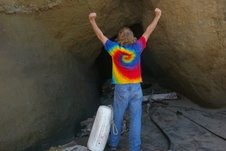 Email John Vonderlin ([email protected])
Email John Vonderlin ([email protected])
Hi Russell,
I was just looking at some of your geometric creations on various websites. Pretty amazing. I’m afraid my lack of knowledge of your specialty makes the jargon seem like a foreign language though. I thought it interesting that two of your main interests revolve around different definitions of topolgy. Number 1 and 3?
- Topographic study of a given place, especially the history of a region as indicated by its topography.
- Medicine The anatomical structure of a specific area or part of the body.
- Mathematics The study of the properties of geometric figures or solids that are not changed by homeomorphisms, such as stretching or bending. Donuts and picture frames are topologically equivalent, for example.
- Computer Science The arrangement in which the nodes of a LAN are connected to each other.
About the only place I venture into such esoteric territory involves my natural(?) knot collection.
Though many of the best specimens in my driftwood collection involve knots, in this case I’m referring to the kinds of knots rope, fishing line, etc, form. While gathering my huge non-buoyant marine debris collection I noticed that ropes, exposed to enough wear bumping along the bottom, were reduced to their most durable parts, just like waterlogged wood, and plastic bottles, etc. That most durable part was a knot in a rope’s case..
At some point I wondered if the properties that give rope knots durability were similar to the forces that might have allowed inorganic compounds to persist long enough to increase their complexity as they slowly “evolved” towards what we now call organic compounds and life?
While knots seem to be getting more scientific study these days, they’ve mystified me since I was taught to tie my shoes. Something, I apparently didn’t learn very well given how many times I usually need to retie my round, nylon shoelaces during one of my bushwhacking adventures.
When you wrote about the Kelphorns you used to make, I was reminded of the only part I ever collect from Bull Kelp, that being knotted pieces of their stipe. I’ve attached a photo of one I just gathered last week. Below is an interesting website detailing the uses the coastal Indians put Bull Kelp to. Though rattles, along with many other things, were made out of them, there is no mention of Kelphorns. You might want to get a patent. Enjoy. John


